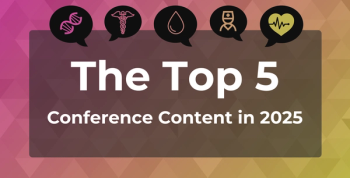
Long-Term Data Show Favorable Survival Outcomes With G-Clb in Treatment-Naive CLL
Key Takeaways
- Obinutuzumab combined with chlorambucil showed superior overall survival compared to rituximab in the CLL11 trial.
- Obinutuzumab's glycoengineered type II CD20 antibody design contributes to its efficacy in eradicating minimal residual disease.
Participants in the CLL11 trial and a smaller group of patients followed after study completion showed improved overall survival with obinutuzumab and chlorambucil (G-Clb) compared with chemotherapy plus rituximab or chemotherapy alone for chronic lymphocytic leukemia (CLL).
The phase 3 CLL11 trial (NCT01010061) and supplementary long-term survival data following study completion support the choice of obinutuzumab (Gazyva; Genentech) as the immunotherapy agent in chemoimmunotherapy (CIT) for
While treatment regimens based on Bruton tyrosine kinase inhibitors and/or B-cell lymphoma-2 inhibitors have become a mainstay of CLL treatment, anti-CD20 monoclonal antibodies, such as obinutuzumab, remain an important component of newer treatment combinations.
The original readout of CLL11 was
Now with overall survival (OS) data from the final readout available in
“While durable control of CLL is a desirable therapeutic goal, an ultimate purpose of treatment is to prolong overall survival,” the researchers wrote. “In our study, the most striking benefit observed for CLL11 patients receiving G-Clb instead of R-Clb was prolongation of OS. This could be due to the different abilities of the two antibody regimens to eradicate minimal residual disease in CLL.”
While both are anti-CD20 antibodies, obinutuzumab is a glycoengineered type II CD20 antibody, and rituximab is a type I CD20 antibody, meaning a different mode of binding to CD20 antigen.
Among the 2 CIT regimens, G-Clb resulted in significantly longer survival compared with R-Clb. Median OS was not reached among patients receiving G-Clb and was 73.1 months for those receiving R-Clb (HR, 0.76; 95% CI, 0.60-0.97; P = .0245). Five-year OS rates were 66% for G-Clb (range, 61%-72%) and 57% for R-Clb (range, 51%-62%).
Available long-term follow-up for 35 patients also suggested favorable outcomes for G-Clb over R-Clb, though the researchers cautioned against generalizability of disease control findings due to the small number of patients.
Following study completion, the 35 patients were followed in a national registry for an average of approximately 10 years, with a median observation time of 118.7 months (range, 42.4-122.3) for patients receiving G-Clb and 124 months (range, 47.7-146.3) for patients receiving R-Clb. Eight-year time to next treatment rates were 56% for the G-Clb arm and 0% for the R-Clb arm (median, 101.5 vs 41.6 months; HR, 0.36; 95% CI, 0.14-0.88; P = .025), and 8-year event-free survival rates were 25% for G-Clb and 5% for R-Clb (median, 46.9 vs 17.5 months, respectively; HR, 0.35; 95% CI, 0.16-0.76; P = .008).
Median OS was not reached for either group of patients (HR, 0.86; 95% CI, 0.32-2.32; P = .768), and 8-year OS rates were 61% for the G-Clb arm and 57% for the R-Clb arm.
“These data suggest that CIT of CLL with obinutuzumab/chlorambucil could achieve long-lasting remissions over many years in patients with favorable genetic risk and that secondary myeloid neoplasia is uncommon. However, long-term remissions appear to be rarer than after FCR,” explained the researchers, noting that nearly half of patients with mutated IGHV showed durable remissions of over 15 years with treatment with fludarabine, cyclophosphamide, and rituximab (FCR).
In addition to the different binding modes of the 2 antibodies, CIT and FCR differ in the chemotherapies used. G-Clb uses a milder chemotherapy than FCR.
"In summary, the results of our study provide evidence that obinutuzumab is an
effective CD20 antibody with potential to provide long-term benefits including survival," the authors wrote. "Findings of our study are in support of current strategies to explore this antibody as part of modern combination regimens."
References
- Goede V, Fischer K, Robrecht S, et al. Long-term outcomes of chemoimmunotherapy with obinutuzumab/chlorambucil in chronic lymphocytic leukemia. Blood Adv. Published online March 20, 2025. doi:10.1182/bloodadvances.2024014875
- Goede V, Fischer K, Busch R, et al. Obinutuzumab plus chlorambucil in patients with CLL and coexisting conditions. New Engl J Med. 2014;370:1101-1110. doi:10.1056/NEJMoa1313984
Newsletter
Stay ahead of policy, cost, and value—subscribe to AJMC for expert insights at the intersection of clinical care and health economics.









































